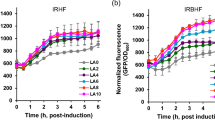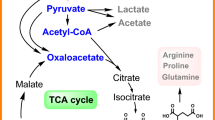Abstract
An Escherichia coli strain, JM109, was successfully engineered into an efficient hyaluronic acid (HA) producer by co-expressing the only known class-II HA synthase from a Gram-negative bacterium (Pasteurella multocida) and uridine diphosphate-glucose dehydrogenase from E. coli K5 strain. The engineered strain produced about 0.5 g/L HA in shake flask culture and about 2.0–3.8 g/L in a fed-batch fermentation process in a 1-L bioreactor. The sharp increase in viscosity associated with HA accumulation necessitated pure oxygen supplement to maintain fermentation in aerobic regime. Precursor supply during HA synthesis was probed by glucosamine supplement, which shortens biosynthesis pathway and eliminates one step requiring ATP. HA synthesis was increased with glucosamine supplement from 2.7 to 3.7 g/L (37%), which was mirrored with a concomitant 42% decrease in pure oxygen input, suggesting a close connection between energy metabolism and precursor supply. Decoupling HA synthesis from cell growth by using fosfomycin (an inhibitor for cell wall synthesis) led to a 70% increase in HA synthesis, suggesting detrimental effects on HA synthesis from cell growth via precursor competition. This study demonstrates a potentially viable process for HA based on a recombinant E. coli strain. In addition, the precursor supply limitation identified in this study suggests new engineering targets in subsequent metabolic engineering efforts.





Similar content being viewed by others
References
Arrecubieta C, Hammarton TC, Barrett B, Chareonsudjai S, Hodson N, Rainey D, Roberts IS (2001) The transport of group 2 capsular polysaccharides across the periplasmic space in Escherichia coli. J Biol Chem 276:4245–4250
Beis K, Collins RF, Ford RC, Kamis AB, Whitfield C, Naismith JH (2002) Three-dimensional structure of Wza, the protein required for translocation of group 1 capsular polysaccharide across the outer membrane of Escherichia coli. J Biol Chem 279:28227–28332
Bitter T, Muir M (1962) A modified uronic acid carbazole reaction. Anal Biochem 4:330–334
Chien LJ, Lee CK (2007a) Enhanced hyaluronic acid production in Bacillus subtilis by co-expressing bacterial hemoglobin. Biotechnol Prog 23:1017–1022
Chien LJ, Lee CK (2007b) Hyaluronic acid production by recombinant Lactococcus lactis. Appl Microbiol Biotechnol 77:339–346
Chong BF, Blank LM, Mclaughlin R, Nielsen LK (2005) Microbial hyaluronic acid production. Appl Microbiol Biotechnol 66:341–351
Day R, Mascarenhas M (2004) Signal transudation associated with hyaluronan. In: Garg H, Hales C (eds) Chemistry and biology of hyaluronan. Elsevier, New York, pp 153–174
DeAngelis PL, Papaconstantinou J, Weigel PH (1993) Molecular cloning, identification, and sequence of the hyaluronan synthase gene from group A Streptococcus pyogenes. J Biol Chem 268:19181–19184
DeAngelis PL, Jing W, Drake RR, Achyuthan AM (1998) Identification and molecular cloning of a unique hyaluronan synthase from Pasteurella multocida. J Biol Chem 273:454–8458
DeAngelis PL (1999) Hyaluronan synthases: fascinating glycosyltransferases from vertebrates, bacterial pathogens, and algal viruses. Cell Mol Life Sci 56:670–682
Drummelsmith J, Whitefield C (2000) Translocation of group 1 capsular Polysaccharides to surface of Escherichia coli requires a multimeric complex in the out membrane. EMBO J 19:57–66
Galassi G, Brun P, Radice M, Cortivo R, Zanon GF, Genovese P, Abatangelo G (2000) In vitro reconstructed dermis implanted in human wounds: degradation studies of the HA-based supporting scaffold. Biomaterials 21:2183–2191
Laurent TC, Laurent UB, Fraser JR (1996) Serum hyaluronan as disease marker. Ann Med 28:241–253
Mahoney DJ, Blundell CD, Day AJ (2001) Mapping the hyaluronan-binding site on the link module from human tumor necrosis factor-stimulated gene-6 by site-directed mutagenesis. J Biol Chem 276:22764–22771
Mao Z, Chen RR (2007) Recombinant synthesis of hyaluronan by Agrobacterium sp. Biotech Prog 23:1038–1042
Meyer K (1947) The biological significance of hyaluronic acid and hyaluronidase. Physiol Rev 27:335–339
Ni Y, Mao Z, Chen RR (2006) Outer membrane mutation effects on UDP-glucose permeability and whole-cell catalysis rate. Appl Microbiol Biotechnol 73:384–393
Nobel PW (2002) Hyaluronan and its catabolic products in tissue injury and repair. Matrix Biol 21:25–29
Powell JD, Horton MR (2005) Threat matrix: low-molecular-weight hyaluronan (HA) as a danger signal. Immunol Res 31:207–218
Ruffing A, Mao Z, Chen RR (2006) Metabolic engineering of Agrobacterium sp. for UDP-galactose regeneration and oligosaccharide synthesis. Metab Eng 8:465–473
Toole BP, Wight TN, Tammi MI (2002) Hyaluronan–cell interactions in cancer and vascular disease. J Biol Chem 277:4593–4596
Turino GM, Cantor JO (2003) Hyaluronan in respiratory injury and repair. Am J Respir Crit Care Med 167:1169–1175
Weigel PH (2002) Functional characteristics and catalytic mechanisms of the bacterial hyaluronan synthases. IUBMB Life 54:201–211
Widner B, Behr R, Dollen SV, Tang M, Heu T, Sloma A, Sternberg D, DeAngelis PL, Weigel PH, Brown S (2005) Hyaluronic acid production in Bacillus subtilis. Appl Environ Microb 71(7):3747–3752
Whitfield C (2006) Biosynthesis and assembly of capsular polysaccharides in Escherichia coli. Annu Rev Biochem 75:39–68
Yu H, Stephanopoulos G (2008) Metabolic engineering of Escherichia coli for biosynthesis of hyaluronic acid. Metab Eng 10:24–32
Zeng C, Toople BP, Kinney SD, Kuo JW, Stamenkovic I (1998) Inhibition of tumor growth in vivo by hyaluronan oligomers. Int J Cancer 77:396–410
Zhuo L, Yoneda M, Zhao M, Yingsung W, Yoshida N, Kitagawa Y, Kawamura K, Suzuki T, Kimata K (2001) Defect in SHAP–hyaluronan complex causes severe female infertility, a study by inactivation of the Bikunin gene in mice. J Biol Chem 276:7693–7696
Acknowledgment
Funding from National Science Foundation (BES-0455193) is gratefully acknowledged.
Author information
Authors and Affiliations
Corresponding author
Rights and permissions
About this article
Cite this article
Mao, Z., Shin, HD. & Chen, R. A recombinant E. coli bioprocess for hyaluronan synthesis. Appl Microbiol Biotechnol 84, 63–69 (2009). https://doi.org/10.1007/s00253-009-1963-2
Received:
Revised:
Accepted:
Published:
Issue Date:
DOI: https://doi.org/10.1007/s00253-009-1963-2




